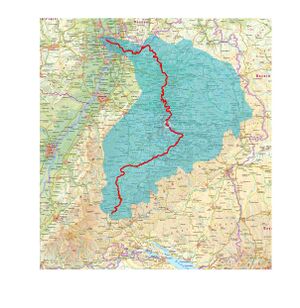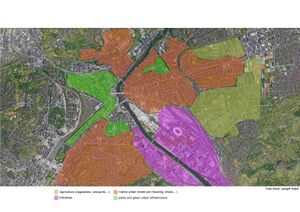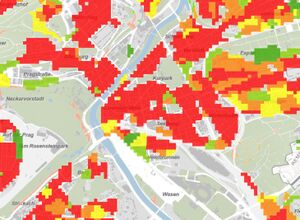WAVE Case Study Neckarinsel Stuttgart: Difference between revisions
| Line 268: | Line 268: | ||
== References == | == References == | ||
* '' | * WSA Neckar. Online: https://www.wsa-neckar.wsv.de/Webs/WSA/Neckar/DE/Startseite/startseite_node.html | ||
* Landeshauptstadt Stuttgart (2017): Erlebnisraum Neckar. Ein Masterplan für Stuttgart als Stadt am Fluss. | |||
* LUBW (2007): Der Neckar. Das Land und sein Fluss. | |||
* leo-bw.de: Staustufen, Schiffsverkehr und Kraftwerke. Online: https://www.leo-bw.de/themen/natur-und-umwelt/neckar/staustufen-schiffsverkehr-und-kraftwerke | |||
* '''©''' 2022 Landeshauptstadt Stuttgart; Straßen‐ und Wegenetz: © ODbL1.0; Nutzungsflächen aus Basis‐DLM: © LGL‐BW. Online: https://gis6.stuttgart.de/maps/index.html?karte=umwelt&embedded=false#basemap=0 | |||
= Process Reflection = | = Process Reflection = | ||
Revision as of 20:28, 2 May 2022
>>>back to working groups overview
| Area | Neckar Bad Cannstatt | |
| Place | Stuttgart | |
| Country | Baden-Württemberg, Germany | |
| Topics | Re-Connecting to the Neckar | |
| Author(s) | Anna-Kathrin Schneider | |

| ||
Rationale
The Neckar is included and fit into human usages in the area, where its passing though Stuttgart and it divides Stuttgart Bad Cannstatt from the inner city. Through that the study area is a point of connectivity and mobility in each manner. In history the people in charge of of the urban water site switched and now multiple stakeholders are somehow connected to that. For the inhabitants the study area is just a point of crossing and moving, while totally disconnected to river. Moreover, in the future there will be a shift of usages of railways, new ones are under construction right now, additionally the contracts for electric power generation with the big companies will end 2034. These shifts could be used to re-shape and re-connected the people to the river.
Location and scope
You can edit this map with the map editor
Water as a natural system
Geomorphology, typologies and dynamics of water areas
The Neckar flows from its origin near Schwenningen to Mannheim, where it leads into the Rhein. Er überbrückt damit eine Distanz von 371 km und eine Höhendifferenz von 621 m.
The development of the catchment area started already in the Cretaceous period with the cave in of the Oberrheingraben and the beginning rise of the Swabian Alb. Consequently, the catchment areas of Danube and the earlier river Rhein changed. The Neckar receives its water now from 13.600 sqkm catchment area. Important is the perception minus evaporation in that area. The water level therefore depends highly on weather, so seasonal and shortly changes are visible. The average yearly perception in the catchment area are between 600mm to 800mm.
Water as a living space
In Stuttgart's urban environment and due to the expansion of the federal waterway, the Neckar has been increasingly forced into a built corset in recent centuries. Nature conservation and environmental protection, as well as biodiversity, hardly played a role. North of Stuttgart, between Aldingen and Stuttgart-Mühlhausen, lies the nature reserve "Oeffinger Scillawald". It is named after the large occurrence of blue star and consists of a deciduous forest that used to be frequently found along the Neckar. This is the only nature reserve along the Neckar near Stuttgart. Up to Plochingen, the end point of the waterway, the river and the riverbank are industrially used and deformed.
In addition to the Neckar, there are 16 other streams in the Stuttgart area. Their total flow length is approx. 150 kilometres, the longest stream being the Feuerbach with a length of 11.5 km. There are also other standing waters in the Stuttgart area. The largest lake is the Max-Eyth-See with an area of 17.3 hectares. (State Capital Stuttgart Civil Engineering Office (2020): Portrait of Stuttgart's water bodies)
The water quality of the Neckar suffered and still suffers from the various industrial uses and structural changes. The 27 barrages slow down the flow, which can lead to a lack of oxygen as there is no longer any turbulence. The critical mark is below 4mg oxygen/litre (LUBW; https://www.lubw.baden-wuerttemberg.de/wasser/chemischer_zustand).
Likewise, sewage treatment plants discharge their treated wastewater into the Neckar, but polluted water is still fed into the river. Swimming in the Neckar is therefore not recommended.
Furthermore, rising temperatures affect the water temperature and thus the ecological condition of the water body. The critical mark of 28° degrees should not be exceeded. However, the water of the Neckar is used as cooling water by the industries on its banks. If the water temperature rises, the power plants must reduce their output in order to protect the "Neckar" habitat. (Regierungspräsidium Stuttgart (27.08.2018): Hohe Temperaturen im Neckar: Regierungspräsidium erteilt Ausnahmeerlaubnisse für drei Kraftwerke der EnBW, Pressemitteilung). The following graphs show how precipitation in the Stuttgart area affects the water temperature and oxygen content of the Neckar with a slight delay. The increased inflow of rainwater lowers the temperature and the increased flow velocity allows more oxygen to enter. The fourth graph shows the rising water temperatures over the course of the year.
Within the framework of the Baden-Württemberg Surface Water Ordinance, the Neckar in the urban area of Stuttgart is assigned to the fish community of the epipotamal. This fish community includes, for example, eel, bitterling, flounder, pike, rudd, tench and zander. The species-specific preferred temperatures for this fish community are up to 25° degrees in summer and up to 10° degrees in winter. (LAZBW(2020): Assignment of fish communities and resulting temperature requirements according to the Surface Water Ordinance in Baden-Württemberg)
Blue and Green Infrastructure
The Neckar river has a major function in the climatic situation of the urban area. Following maps from the City Surveyor's Office and Geoinformation show the climatic situation around the area and the impact of the river.
The build up area along the river is highly burdened with urban structures and resulting climatic conditions. The local residents are highly vulnerable towards climatic changes. And even the Rosensteinpark has a high exposure to heat in summer. Especially the old town of Bad Cannstatt and the residents there will have to deal with urban heat islands and therfore heat stress due to climate change.
The intense traffic and important mobility hub (bridges between Bad Cannstatt and inner city) lead to high noise pollution and the formation of nitrogen dioxide. The Neckar Island is also affected by this.
- What are the major potential elements of a green/blue infrastructure network? Are these likely to change/disappear? Why is that?
- You find my background material on green infrastructure in our reading list
- add 1-2 graphical representations to the image gallery, you can add more if you like
Water as a cultural space
Land use and water
The Neckar has always represented an important landscape marker and use. For example, the middle course (between Rottenburg and Bad Wimpfen) was the north-eastern border of the Roman Empire for seventy years. (LUBW 2007; p. 46f.) The Romans also navigated the Neckar with rafts. The first successful development of the river was achieved by the Duke of Württemberg in 1821. In 1878, chain-towed navigation opened between Mannheim and Heilbronn. The expansion of locks and weirs took until 1935. Then the shipping route from Mannheim to Heilbronn (113km) could be opened. The Second World War not only slowed down further expansion, but also destroyed many bridges. Motorboats then made it possible for a few people to cross. However, the expansion was resumed after the World War, so that the port of Plochingen could be opened at the end of the 20th century, making 201km of the Neckar navigable. The total of 27 barrages also function as hydroelectric power stations for generating electricity and almost all of them were designed by the architect Paul Bonatz. (leo-bw)
The Neckar is approved for large Rhine ships up to 110m in length and up to 3000 (t) in tonnage. (Classification of the federal waterway: Class V a).
The extract from the Digital Federal Waterways Map gives an overview of the shippable Neckar and the location of the barrages.
Masterplan "Neckar experience area" and the IBA projects
- blabla
- Yourcase water space1.jpg
add a caption
- Yourcase water space2.jpg
add a caption
- Yourcase water space3.jpg
add a caption
Visual appearance and landscape narrative
The river also played a role in poetry.
Friedrich Hölderlin a well-known German writer and poet lived from 1770-1843 and wrote a famous poem about the Neckar.
Der Neckar
(written around 1800-1806)
In deinen Tälern wachte mein Herz mir auf
Zum Leben, deine Wellen umspielten mich,
Und all der holden Hügel, die dich
Wanderer! kennen, ist keiner fremd mir.
Auf ihren Gipfeln löste des Himmels Luft
Mir oft der Knechtschaft Schmerzen; und aus dem Tal,
Wie Leben aus dem Freudebecher,
Glänzte die bläuliche Silberwelle.
Der Berge Quellen eilten hinab zu dir,
Mit ihnen auch mein Herz und du nahmst uns mit,
Zum stillerhabnen Rhein, zu seinen
Städten hinunter und lustgen Inseln.
Noch dünkt die Welt mir schön, und das Aug entflieht
Verlangend nach den Reizen der Erde mir,
Zum goldenen Paktol, zu Smyrnas
Ufer, zu Ilions Wald. Auch möcht ich
Bei Sunium oft landen, den stummen Pfad
Nach deinen Säulen fragen, Olympion!
Noch eh der Sturmwind und das Alter
Hin in den Schutt der Athenertempel
Und ihrer Gottesbilder auch dich begräbt,
Denn lang schon einsam stehst du, o Stolz der Welt,
Die nicht mehr ist. Und o ihr schönen
Inseln Ioniens! wo die Meerluft
Die heißen Ufer kühlt und den Lorbeerwald
Durchsäuselt, wenn die Sonne den Weinstock wärmt,
Ach! wo ein goldner Herbst dem armen
Volk in Gesänge die Seufzer wandelt,
Wenn sein Granatbaum reift, wenn aus grüner Nacht
Die Pomeranze blinkt, und der Mastixbaum
Von Harze träuft und Pauk und Cymbel
Zum labyrinthischen Tanze klingen.
Zu euch, ihr Inseln! bringt mich vielleicht, zu euch
Mein Schutzgott einst; doch weicht mir aus treuem Sinn
Auch da mein Neckar nicht mit seinen
Lieblichen Wiesen und Uferweiden.
(Source: https://www.textlog.de/17837.html#google_vignette)
Water and People
Accessibility and usability
Community Mapping
- For each group, you may identify their needs, objectives, power and capacities
- Please try to redepict these elements in an integrated way and in relation to your water landscape. What is the relationship between these groups? Are they close or distanced from each other? Who is more powerful? Which voices are hardly heard? Do they have any shared concerns?
Possible Futures
- You can summarize your findings with a SWOT diagram and a DPSI(R) Model
- Link back to the Sustainable Development Goals: Which goals are at risk?
- What is your worst case scenario for this landscape?
- What is your best case scenario for this landscape?
- Present your scenarios in the form of a collage or sketch
- Add text and visuals
- Your case your spider diagram or dpsir model.jpg
explain your analysis briefly in the caption
- Your case yourworstcase visual.jpg
explain your worst case scenario briefly in the caption
- Your case yourbestcase visual.jpg
explain your best case scenario briefly in the caption
Collaborative Goal Setting
- Define strategic planning objectives based on the evaluation findings from your analysis
- Ideally, involve the community of your living labs into this process
- Link back to your original targets from section one and the Development Goals
- 150 words text contribution
Spatial Strategy and Transect
- translate your strategic goals into a vision
- develop a spatial translation of your vision
- exemplify your vision in the form of a transect with concrete interventions
- add map(s) and visualizations
- Your case spatial translaton vision.jpg
add caption here
- Your case transect.jpg
add caption here
- Your case transect detail1.jpg
add caption here
- Your case transect detail2.jpg
add caption here
From Theory of Change to Implementation
- For implementing your vision: Which partnerships are needed? Which governance model is required?
- Who needs to act and how? Draw and explain a change/process model/timeline
- Which resources are needed? On which assets can you build?
- add 150 words text and visuals
References
- WSA Neckar. Online: https://www.wsa-neckar.wsv.de/Webs/WSA/Neckar/DE/Startseite/startseite_node.html
- Landeshauptstadt Stuttgart (2017): Erlebnisraum Neckar. Ein Masterplan für Stuttgart als Stadt am Fluss.
- LUBW (2007): Der Neckar. Das Land und sein Fluss.
- leo-bw.de: Staustufen, Schiffsverkehr und Kraftwerke. Online: https://www.leo-bw.de/themen/natur-und-umwelt/neckar/staustufen-schiffsverkehr-und-kraftwerke
- © 2022 Landeshauptstadt Stuttgart; Straßen‐ und Wegenetz: © ODbL1.0; Nutzungsflächen aus Basis‐DLM: © LGL‐BW. Online: https://gis6.stuttgart.de/maps/index.html?karte=umwelt&embedded=false#basemap=0
Process Reflection
- Reflect in your intercultural and interdisciplinary team on the outcomes of your study
- Which limitations were you facing?
- What have you learnt from each other?
- What did you learn in the Living Labs?
- What would you do differently next time?
- You can also use diagrams/visuals
- 250 words text


















